Friday 28th October 2022
Open Lecture on BLK Art Movement
Togetherness and BLK Art Movement 40th Year Anniversary of BLK Art Group Conference at Wolves Polytechnic. (MK Building) (Originally 28th October 1982)
Hosted by Laura Onions, Gavin Rogers and Jason (Product Design lecturer)
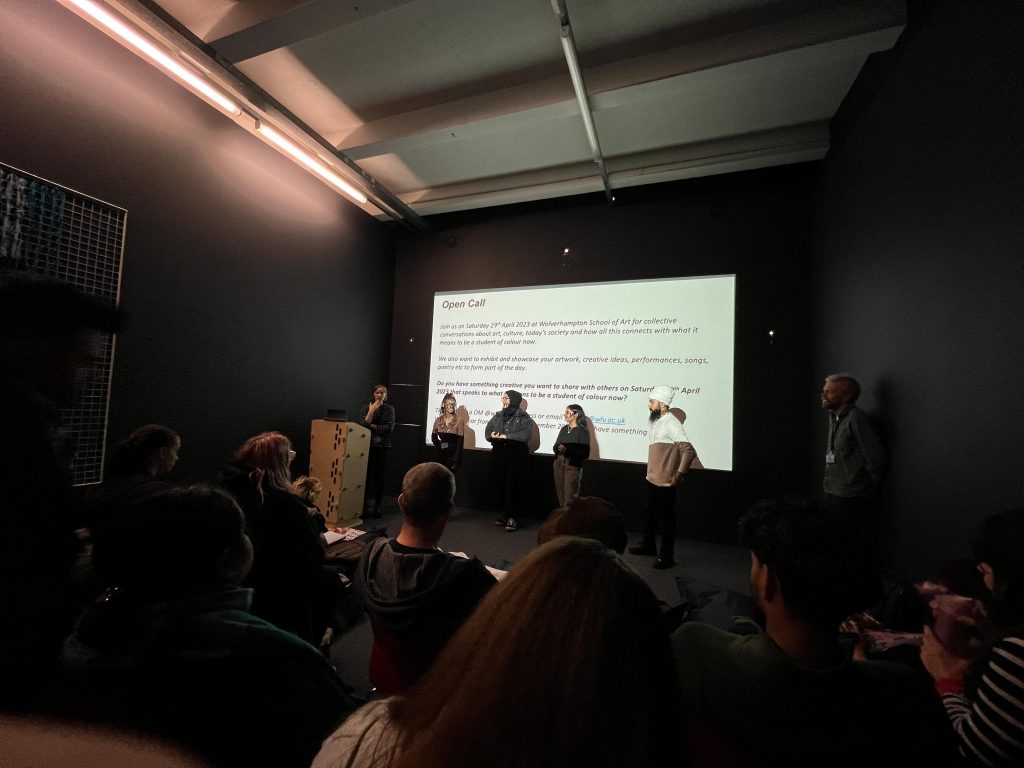
40 Years ago since the BLK Art conference in the MK building
Keith Piper, one of the artists, was quoted as saying it was for the “form, function and future of black art” in the video
Art was very politically charged in the 80s due to the prejudices that existed in abundance.
They had been gathering together for the 3 years prior and decided to hold a conference to all work as a single group
The definition on the slide for Black* was People Of Colour, Global Majority, Politically Othered, and politically black. Most of these are new terms to me as I’d honestly never come across them before.
Interestingly Cambridge Online Dictionary defines Global Majority as “Global majority refers to people who are Black, Asian, Brown, dual-heritage, indigenous to the global south, and/or have been referred to as “ethnic minorities“.
Every day is a school day for me at the moment.
A video hosted on MACE Video Archive (https://www.macearchive.org/films/here-and-now-21111982-black-art) shows Marlene Smith and Eddie Chambers talking about the BLK Art group and the conference at Wolverhampton.
There were 20 artists showing 40 pieces of art in the 1982 exhibition.
When asked about the politics of the art Chambers replied “you can’t separate art from politics” because much of the art they were displaying was highlighting issues of the day. He also explained that the art has more power when it is on display in a gallery or exhibition as it has more credence to it.
The presenter asked an artist Shakka Dedi how he felt about it and he replied that black artists “were working in a vacuum” so to get together and discuss where they were heading and themes was amazing for all involved some of whom had been the only person of colour on their course or workplace.
The timetable is available to read and it shows that the event contained talks, provocations, seminars and film screenings.
Names in the programme of Artists contain
Rashead Araeen, Claudette Johnson, Sonia Boyce, Marlene Smith, Keith Piper and Lubaina Himid who have gone on, in most cases, to be very successful British Artists with illustrious careers.
Eric Roberts at the convention was quoted as saying “we should avoid mimicry. We should try and create our own humanity” and “There’s room on the planet for different points of views”
Eddie Chambers at the age of 17 produced a piece of work titled “Destruction of the National Front (1979/80)” where the union jack flag was mixed with the swastika in a protest at how the Anti-Nazi league were leading the prejudiced activity against immigrants and people of colour. It is a very emotional image and one that would have caused huge controversy in 1980’s Britain where race riots and the rise of Right Wing groups were encouraged by the likes of Enoch Powell etc. Today, it’s an inflammatory image, swastika’s are very seldom seen due to the taboo that has been built around them. To see it on the screen in a lecture was eye-opening and it took me back to when I first watched American History X and the shock of seeing Ed Norton with one emblazoned on his chest.

Gavin explained that some black artists are often fetishised or pressured into making their art political and somehow about society and how black people are treated, but really some people just want to paint pictures or draw things. Lecturers and people who assist artists must remember this when discussing projects with artists at all times.
Sonia Boyce artwork “She ain’t holding them up, she’s holding on (some English rose,) 1986” shows that she was a first generation British black person who was trying to balance in the middle of the family history and culture and blend into the British society.
Boyce won the Golden Lion at the Venice Biennale which is the top prize for her installation “Feeling Her Way” and is the first black woman to represent uk at Venice.
We watched a TATE video of Claudette Johnson explaining her process and thought streams in a video called “Giving space for the presence of a black woman” about how she paints black women and occasionally men. Her art was amazing using very limited palettes and leaving many seemingly unfinished areas of paintings to highlight the person in the image rather than the clothing or environment.
Thought Experiments
We were left with some questions from the lecturers at the end of the session.
Q: What is the role of art education to foster permanent changes?
A: Art education for me allows people to express themselves in a manner without using words, based on their emotions and feelings. It has the opportunity to be provocative and question raising for people who may not have considered the issues that the work is about. The BLK Art group was able to further the goals of the organisation in getting people discussing issues surrounding the representation of Black and Other people of colour’s artwork. The art can be displayed in galleries and given the heightened status of being done by a professional artist as well as furthering the conversations on who created the art and the reasons behind the piece. Encouraging art education informs the ignorant and allows people to update their views that may have been formed in their social circle’s limited viewpoints. It’s about expanding horizons and allowing students and mentees to be encouraged to explore over the horizon
Q: Would you like to be involved with projects around BLK Art group?
A: When I read the question I thought it might be something that would be worthwhile but at the same time, I’d struggle with the fact that I’m in the privileged position of being a middle aged, white male and I don’t know if there would be much I can do apart from being an ally and picking people up if they use incorrect terminology. Time is also something else I’m limited with at the moment between a full time job, part time degree, and a full time family it’s tricky. If there are events I can make it to I’ll certainly attend. The event today was interesting and whilst it shows how far we’ve come since 1982, it’s obvious from today’s society that there is still much work to do with equality, for people of colour and many under represented groups.
Q: What can you do to help raise the profile of under represented artists? What does it mean to be an ally?
A: I guess to help raise profiles I can attend galleries, exhibitions and shows that feature under-represented artists and then write about them on my blog, on Instagram and discuss it with friends, colleagues and family. Discussing artists with people I know will help to get the message out about the artist and their work, including the messages, if any, that they are trying to get across. To be an ally means to support somebody or a group by including them in discussions, decisions and all manner of daily interactions. If people are dismissive of the group I am allied with I will speak up and correct their information in a polite and diplomatic way, and hopefully spread some knowledge and good will. It also helps to try and understand a little of the point of view of the person/group I am an ally with, getting involved in the discussions without trying to steer it too much will help me understand it a little more.
After The Lecture
I was sitting next to Simran in the room and turned and introduced myself to have a chat about the subjects in front of us. We had a chat about how BLK art is important but I was honest with my comments on my concern that I couldn’t really comment on what it’s like for a person of colour to study art or do anything as I’ve not lived in the shoes. I would feel like I was “whitesplaining” and wouldn’t be comfortable trying to guess what it must be like to experience prejudice and racism. We talked about Simran’s art which was on display in the Togetherness Exhibition in the foyer, and how he, as a Sikh man, wears a turban but he explained that he ties his turban differently in a fashion that’s long since been common. He explained that to have the turban tied as he had it was worn by Mughal, Rajput’s and Sikh gurus up to the 6th and 10th Gurus, and he was using his art, and illustration skills to educate people in how this is tied and why it is different to other styles. It was a fascinating conversation and we looked at his art in the foyer afterwards, more on this in a short while.
There is a Togetherness event happening on the 29th April 2023 which will be collective conversations about art, culture today and previously.
Togetherness Exhibition
We then went down into the foyer where we were introduced to the art of a few artists from the school of arts, photography, illustration, product design and painting.
First artist on the wall was Chandni Raiththa a Level 5 Photography student whom I was on Level 4 with last year. Her photo “Black Prince” was an in your face portrait of a person wearing traditional Indian dress and was inspired by a Frida Kahlo piece of work. It’s a striking image that captures your gaze as you stand in front of it.

Next artist was Simran Samra (Sim Sim) who used illustration like an ikea instruction graphic, on how to tie the Royal Indic style of Turban. Alongside this there was a drawing of a Guru which showed full ceremonial dress and then two other drawings of the artist and his sister going about their daily lives.
The illustration of the turban tying was brilliantly done and reminded me of Aircraft Safety Leaflets on how to escape from a crashed jet. It looked really professional.
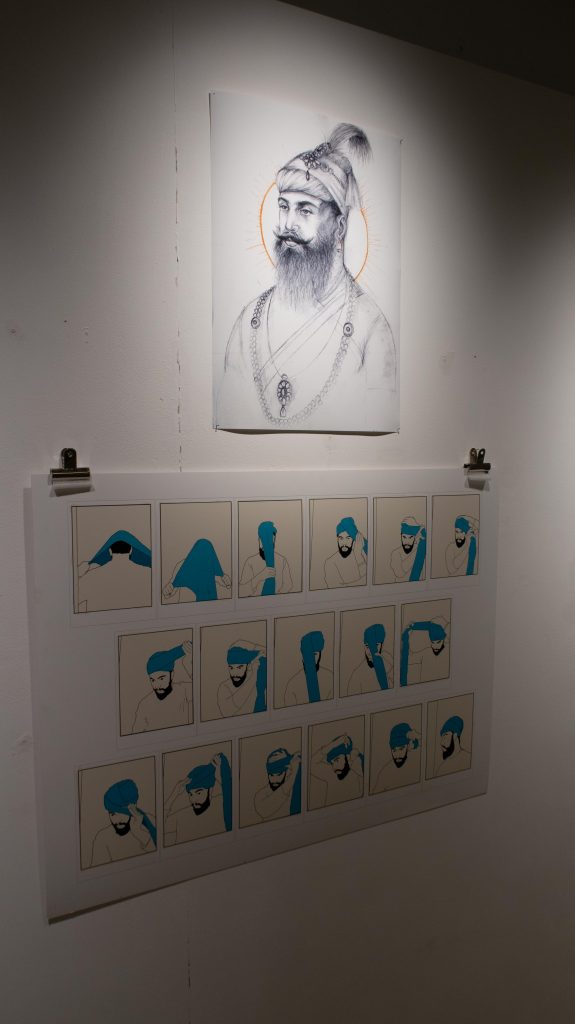
Shannon Ward had created an oil painting of her parents from a photograph from the 80s called “Love makes the world go round” and shows a wonderful image of two young adults embracing in a loving fashion with smiles aplenty.

Kahdijah Kouser was next on the wall with some work called “Nessa” a GPS enabled bracelet to help women deal with the dangers of navigating the world that recently resulted in the death of Sabrina Nessa. She uses product design to make a statement about how women are at risk all the time from wrong doers and it shouldn’t be like this, but this safety device allows friends and family to make sure their friend, daughter, sister is where they should be. Safe.
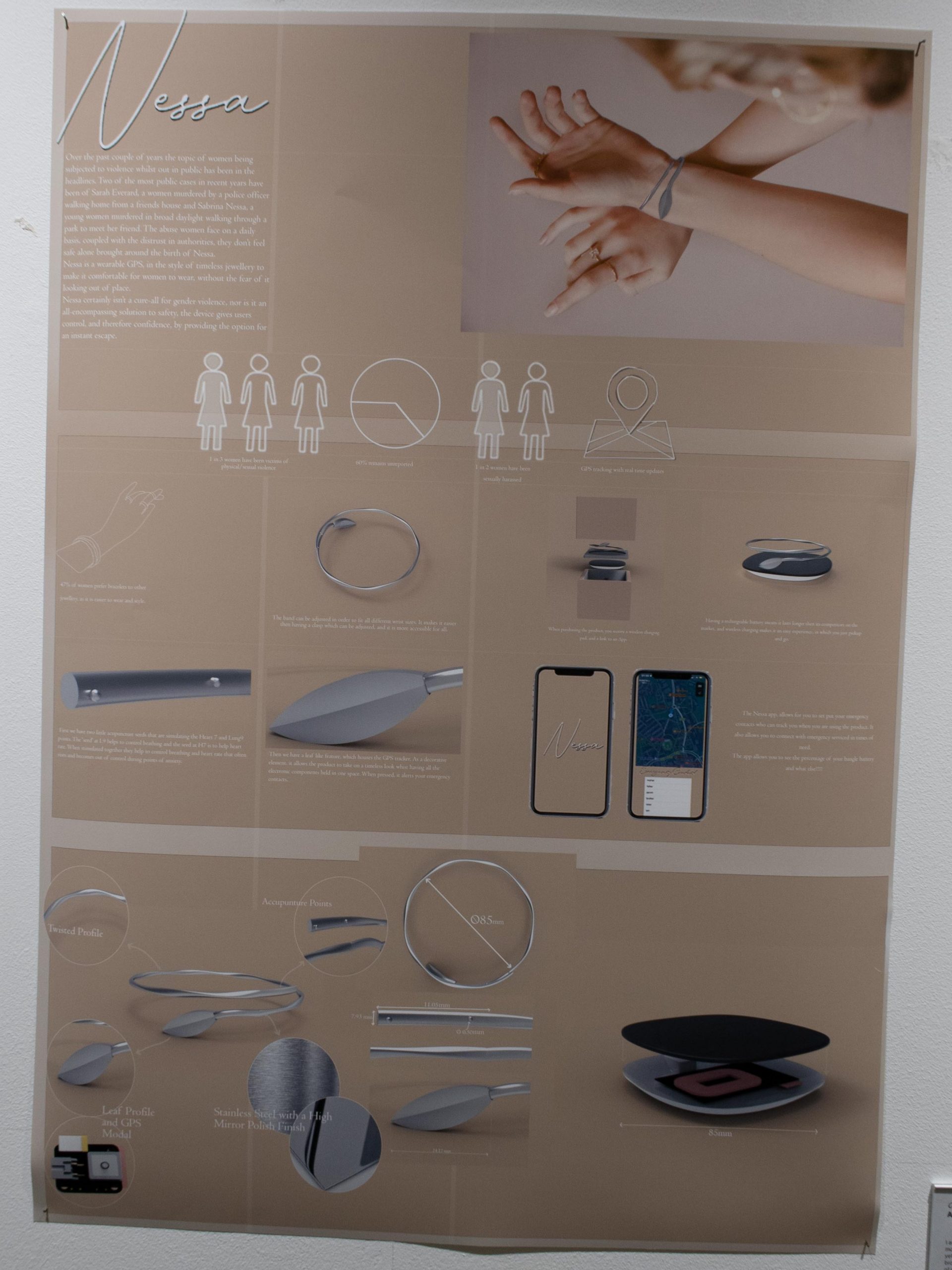
Aparnan Shanmugam also from a design background had created a design for a device called Observia that also used GPS to advise the wearer when they were entering areas considered as high risk or suffering from an increase in anxiety due to a situation they’re in. It looks like an advert for an apple device but the message underlying in it stresses that students are at risk of violence and ne’er-do-wells so strategies are needed to reduce the risk. It’s such a shame that these technologies are considered as required, the world should be a more caring place with fewer idiots around to harm others and make life difficult for the rest of us.
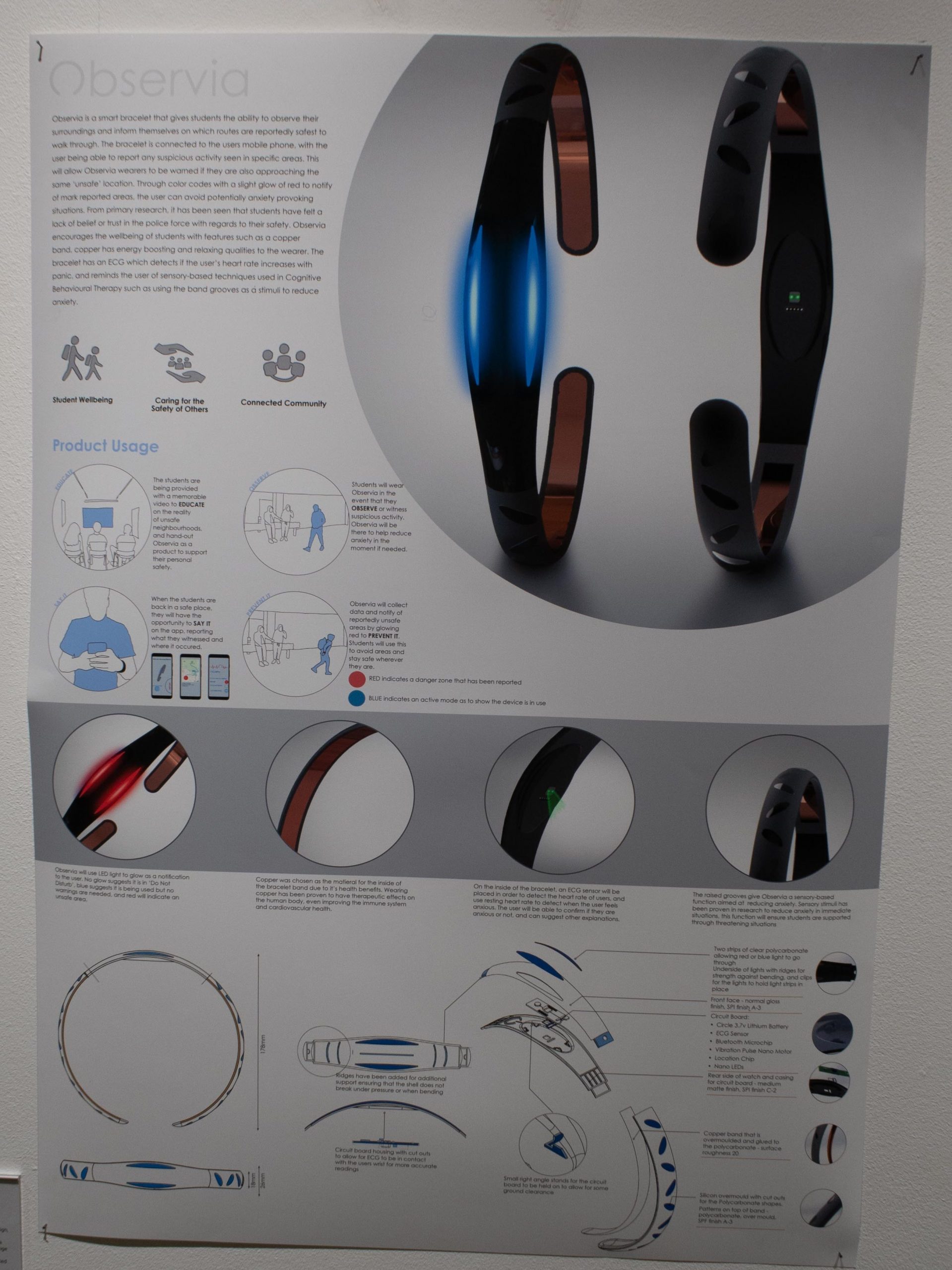
Alina Ahmad presented three photos from. A series titled “Herself” in which she plays with the idea of the Female Gaze and how she is a female taking photos of other women in a passport style manner. The three images on display here are honest portraits as you’d expect for a passport photo with no smiles and any emotions hidden behind the impassive faces of the subjects. Only the eyes hint at any emotion or feelings as they stare out of the image towards you as a viewer.
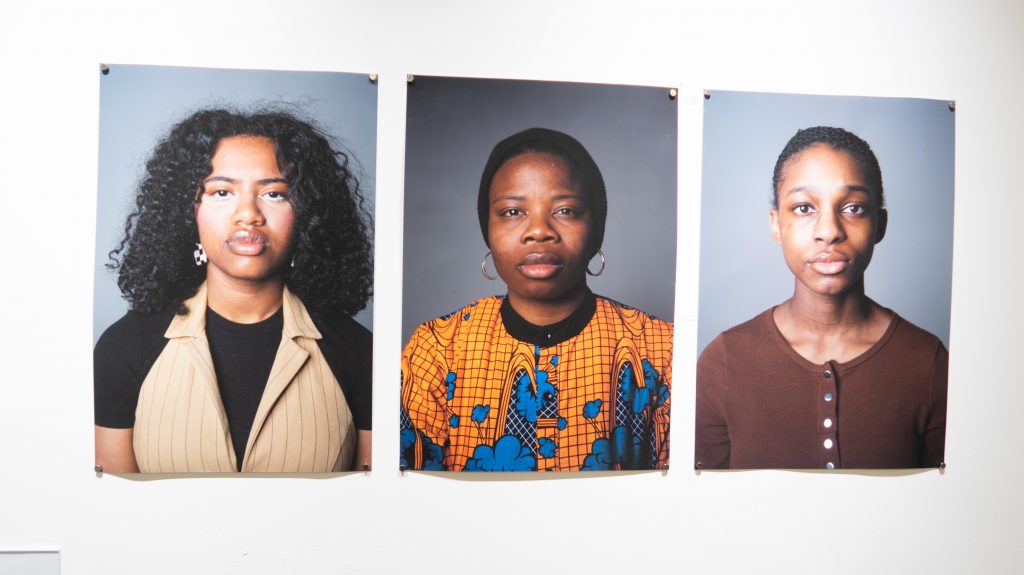
After the exhibition had finished I went into the darkrooms to get on with my Full Year Project beginnings. This follows in a separate post.
Summary
Overall, today was a good learning experience for me to see some of the thoughts and ideas that have come out of the BLK art movement and I’m looking forward to seeing more work from the Togetherness group.
The open lecture provided a sense of the improvements in the art community since the 80s surrounding Black artists but there is still a long long way to go.
I also picked up on some terms that I’d not come across before and will help me hopefully be an ally to the cause of equality.
Comments are closed.